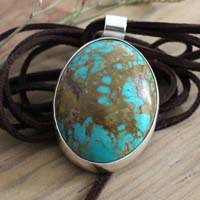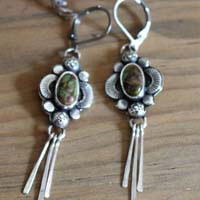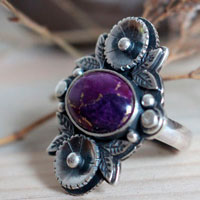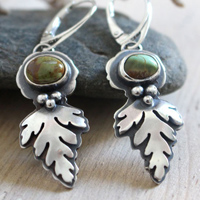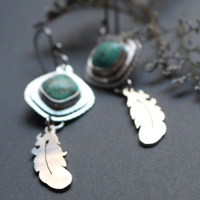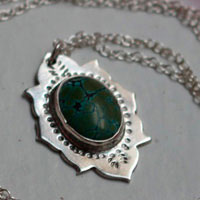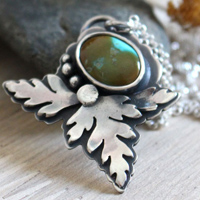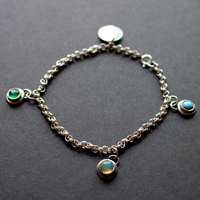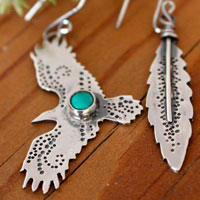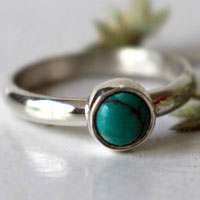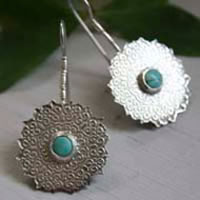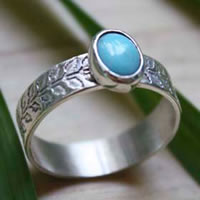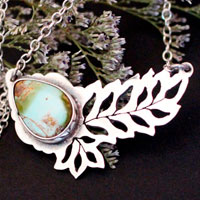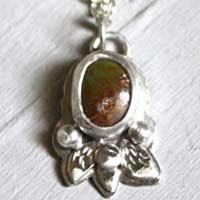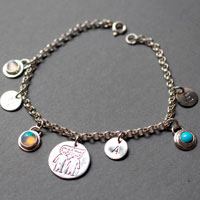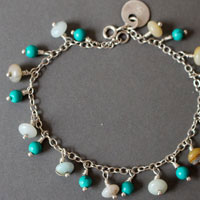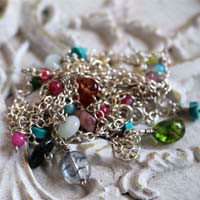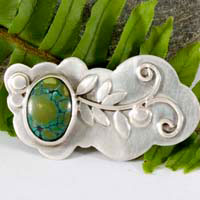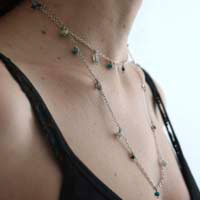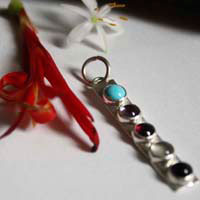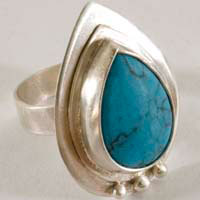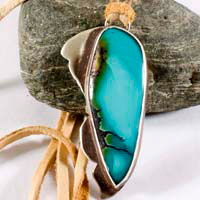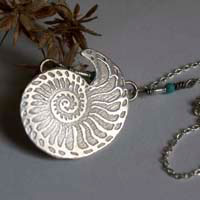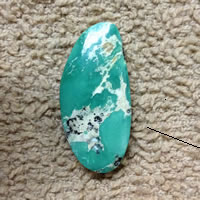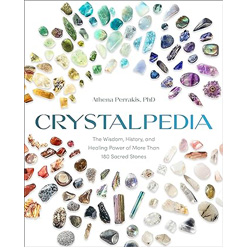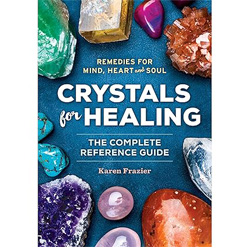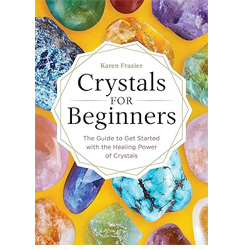- Jewelry
- Inspiration
- Good Deals
- Paintings
- About
- Contact
JEWELRY
- Anklet
- Bracelets
- Brooches
- Cufflinks
- Earrings
- Pendants & Necklaces
- Rings
- Draw your jewelry
- GOOD DEALS
- How to clean your jewel
- Metal we used
INSPIRATION
- Our imagination
- Birthstones
- Druids and druidesses
- Flower meanings
- History, archeology jewelry
- Japanese symbols
- Lithotherapy and stone choice
- Illumination jewelry
- Maya calendar jewelry
- Stone color symbolism
- Stones Catalogue
- Searches a theme on the site
ABOUT
Turquoise: history, healing properties and lithotherapy
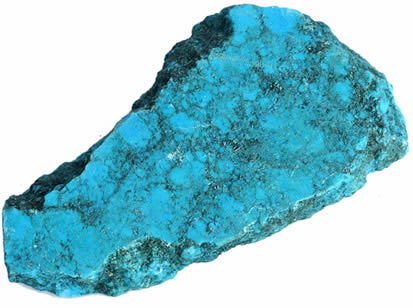
Turquoise properties
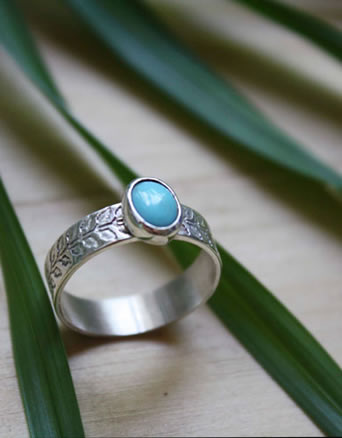
The turquoise, a precious stone with shades of blue-green, takes its name from the French "pierre turque" or "Turkish stone", dating back to the 16th century. Its history is closely linked to the Crusades, a period during which it gained popularity in Europe.
Turquoise, due to its rarity and quality, has been a highly sought-after gemstone for centuries for its unique color. Its appeal is such that it has become extremely popular in the market, which has unfortunately led to the introduction of many imitations, sometimes very difficult to distinguish from the originals, even for experts.
Turquoise is a precious stone of mineral origin, composed of hydrated copper and aluminum phosphate, which gives it its characteristic blue color. However, it is important to note that the presence of iron impurities can sometimes alter its color, giving it a greenish tint.
The imitation of turquoise is a phenomenon that has intensified with the depletion of mines. Since the Egyptian era, techniques such as faience have been used to produce imitations. Today, modern processes such as porcelain and plastic (pressed, glued, and dyed) are commonly employed. Notable examples include Viennese turquoise, obtained by compressing aluminum phosphate, and Neolithic turquoise, a mixture of bayerite and copper phosphate.
These products remain relatively identifiable either physically or chemically, but in 1972, Pierre Gilson presented a synthetic turquoise that was difficult to recognize, except by its chemical composition. It perfectly imitates the colors and veins of natural Nevada turquoise.
The most common imitation is howlite stone, which closely resembles turquoise but is dyed. Other minerals such as chalcedony, jasper, marble, variscite, and faustite are also used, but they are less close to reality.
History, legends and beliefs about turquoise
Turquoise has played a significant role in many ancient cultures. It was revered by Egyptian governors, the Aztecs, and other pre-Columbian civilizations, as well as by the Persians, Mesopotamians, Indians, and Chinese.
The exploitation of turquoise in Iran dates back more than 2000 years. Formerly called "Pirouzeh," which means "victory" in Persian, it was renamed "Firouzeh" after the Arab conquest. This deposit contains stones of a deep blue, but they can turn green when heated.
In the Persian Empire, turquoise was considered a protective talisman against natural death when worn around the neck or as a bracelet. The belief in its power was so strong that its change of color was interpreted as an omen of great misfortune.
Iranian palaces are often adorned with turquoise, symbolizing the sky on earth, an iconic representation of divine beauty and power.

Since the first dynasty of the pharaohs, the Egyptians exploited the mines of the Sinai Peninsula to extract turquoise, which is characterized by its green tones.
This precious stone was highly prized and used in many objects, especially those belonging to the nobility. The most famous example is undoubtedly the funeral mask of Tutankhamun, inlaid with turquoise.
Turquoise was associated with Hathor, the Egyptian goddess of love, beauty, music, maternity, and joy.
Its use in religious and funerary objects testifies to its importance in ancient Egyptian culture.
Turquoise was also used to adorn jewelry and amulets, as it was believed to have protective powers and bring luck to those who wore it.
It was through Turkey that these stones returned to Europe.
It was particularly important for Turkish horsemen who believed it protected their horse from falls. Turquoise was also used as a talisman to protect travelers from the dangers of the road.
The Roman Pliny the Elder called it Callais. This name refers to the city of Callaïs, located in Asia Minor, which was renowned for its turquoise mines.
Turquoise is said to be one of the stones of Aaron’s breastplate described in the Bible (Exodus 28) depending on the interpretations made of it.
In Jewish tradition, each precious stone of Aaron’s breastplate represents one of the twelve tribes of Israel.
Turquoise, associated with the tribe of Zebulun, symbolizes the sea and the sky, thus recalling divine protection and spiritual guidance.
On the American continent, the Aztecs called it Teoxihuitl. It was used in the making of many objects, especially ceremonial ones, in the form of mosaics combining turquoise, gold, quartz, malachite, jade, coral... Objects such as masks (some of which use a human skull as a base), knives, shields...
In the United States, it is believed that the making of jewelry, especially amulets, in turquoise was the main activity and means of development for the Pueblo Indians, especially the Anasazi. The currently recognized activities of other tribes, including the Navajos, would only date back to 1880 due to European influence.
The Apaches and Navajos connected the stone to Estsanatlehi, the goddess of change or "turquoise woman". She was the goddess of the seasons. The Apaches believed that if a turquoise was attached to the bow or rifle of a warrior or hunter, he would never miss his target.
For the Sioux Lakotas, it is associated with Whope, the goddess of peace. Turquoise was often used in healing and purification rituals, as it was believed to have healing and soothing properties.
Apparently, it was unknown in India before the Mughal period and in Japan before the 18th century. However, once introduced, it quickly gained popularity in these regions. In India, it became a symbol of wealth and status, often used in jewelry and royal ornaments. In Japan, it became a key element of art and culture, used in the making of kimonos, jewelry, and art objects.
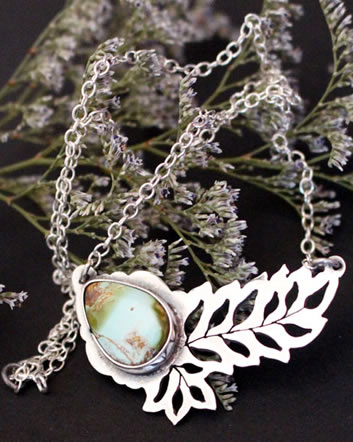
In Europe, turquoise became particularly fashionable in the 1800s following archaeological excavations in Egypt, notably the discovery of the tomb of Tutankhamun. This led to a neo-Egyptian style in architecture, jewelry, and other objects that brought it to the forefront.
Mines: Tanzania, the USA, Iran, Israel, Turkey, Mexico and China.
Healing properties and benefits of turquoise
Turquoise is renowned for its healing properties and health benefits.
- It is believed to combat eye problems, such as eye fatigue and dryness, by improving blood circulation in the eyes and soothing irritations.
- It is also reputed to relieve nasal passages and mucous membranes, helping to clear sinuses and reduce inflammation, which can be beneficial for people suffering from allergic rhinitis or sinusitis.
- Turquoise is believed to stimulate the heart and throat, promoting better blood circulation and soothing throat irritations.
- It is also reputed to dissolve blockages that prevent proper circulation in the body and reduce inflammation, helping to eliminate toxins and waste accumulated in tissues and organs.
- Turquoise is believed to purify the blood, helping to eliminate toxins and waste accumulated in the blood, which can be beneficial for people suffering from skin problems, such as acne or eczema.
- It is also reputed to eliminate toxins from the body, excess acidity, and gout, helping to eliminate waste and toxins accumulated in tissues and organs.
- Turquoise is believed to calm muscle pain and rheumatism, helping to relax muscles and reduce inflammation, which can be beneficial for people suffering from joint or muscle pain.
- It is also reputed to stimulate the pituitary gland and ward off migraines and headaches, helping to regulate hormones and reduce tension in the body.
- Turquoise is believed to help protect the spine, bronchi, from arthritis and asthma, strengthening tissues and organs and improving blood circulation in these areas.
⚠ Please note that all healing properties presented for gemstones are gathered from various sources. This information is provided as a service and is not intended to treat medical conditions. It is recommended to consult a healthcare professional for serious medical issues and not to rely solely on gemstones as a treatment.

